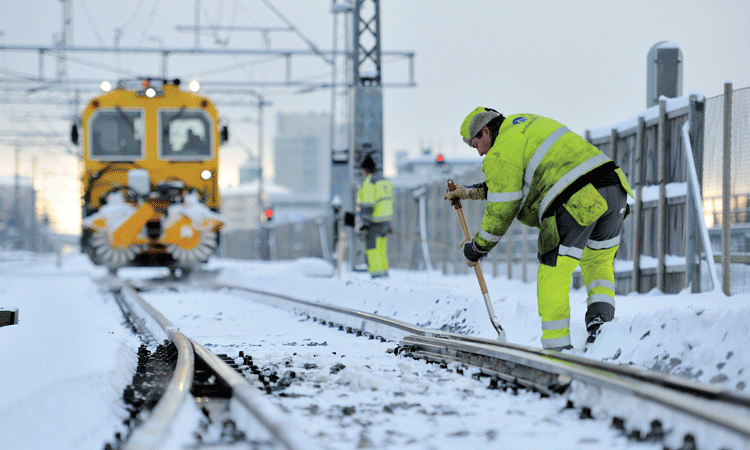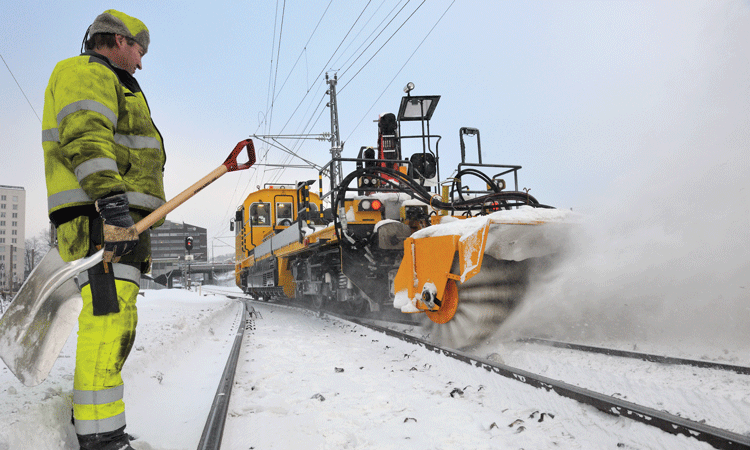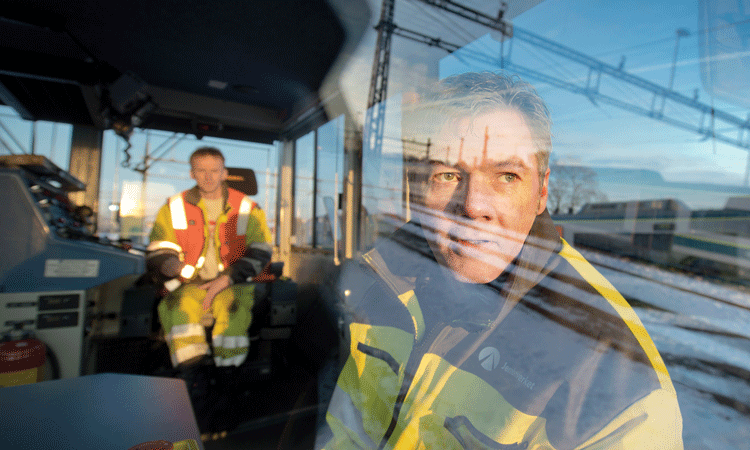How Norway’s railways wins the fight against snow
Posted: 19 November 2014 | Arvid Bardstu, Guttorm Moss, Inge Hjertaas, Thor Erik Skarpen | No comments yet
For the third year in a row, the Norwegian railway achieved its punctuality goal of 90% with trains running somewhat punctually despite the menace of snow and ice – an achievement that requires both science and manpower. In this article, Jernbaneverket’s Guttorm Moss and his colleagues who make sure the country’s rail infrastructure is well maintained and suitable for traffic at all times, explain how Jernbaneverket’s winter preparedness programme is rolled-out, plus how extreme cold weather affects the Bergen Line.


Credit: Oystein Grue / Jernbaneverket
On 15 November, winter preparedness on the Norwegian railway begins. Many measures are implemented; any new snow clearing equipment recently acquired is set to work; clearing personnel are hired; switches and drainage are improved; and the traffic controllers have their dedicated snow clearing coordinators on duty. The Greater Oslo area is a priority; approximately 70% of Norway’s train traffic runs in this region, consisting mainly of daily commuters travelling to and from work. But regardless of weather conditions, commuters expect trains to of course run punctually.
Many measures, better winters
The Scandinavian winter of 2009/2010 was harsh. As a result, the number of recorded delay hours in 2010 was higher than in previous years. Switches, rolling stock and stations were heavily affected by snow and ice. Commuters turned sour and the nation’s press had the railway under fire. Measures had to be taken to avoid any recurrence for coming winters. Analyses were carried out and massive measures were taken by both Jernbaneverket and the train companies. Both manpower and technology were issued. The result; even though the following winter of 2010/2011 was equally cold with heavy snowfall, train traffic fared much better.
“We increased our winter preparedness,” says Guttorm Moss – Permanent Way Superintendent for the Greater Oslo Region at Jernbaneverket. “With more staff plus better machinery and equipment, we were better prepared for heavy snowfall and severely cold temperatures. Regular train services were resumed much quicker, and the 2010 renewal work in the Oslo Tunnel and at Skøyen and Oslo Central Station paid off, as well. ‘Action cards’ for traffic management on how to deal with certain situations, if they were to occur, were improved. The result of all measures combined is a more robust infrastructure with fewer faults. The effects of the upgrades were noticeable during both summer and winter.”
Increased contingency
Jernbaneverket employees are on duty 24/7, ready to be called out for whatever reason – for example, when water collects along the track, a signal system stops working, an overhead line is pulled down, or a flimsy switch fails to assume the intended position. In total, Jernbaneverket has 1,500 employees in a ‘contingency rota’ across the country’s 4,000km-long railway network.
They are usually on their toes during winter and carry out other work when things are all running smoothly. Traffic controls are manned with designated Snow Clearing Coordinators – making sure snow and ice is attended to where and when it is most needed.
Train companies are responsible for their rolling stock and much effort has been put into protecting vulnerable parts from the cold and snow. Defrosting stations were set up to routinely remove built up ice and snow, which otherwise would be cluttering onto the lower parts of rolling stock causing malfunctions on trains and risk of lumps of ice falling onto the tracks.


Snow removal brushes mounted on track machinery working in Oslo. Credit: Oystein Grue / Jernbaneverket
‘Lump patrols’
The ‘Lump Patrol’ (or ‘Ice Guards’) is the most exotic part of this contingency. In winter, when the weather indicates that there will be trouble ahead, the Ice Guards will be ready at tunnel openings when trains arrive. The chances are high that snow and ice will have melted sufficiently inside the tunnel resulting in large lumps of ice to fall off at the first switch. Jernbaneverket’s Ice Guards are ready to respond to ice falling from the trains onto tracks and switches. Temperatures of 25 degrees below freezing and drifting snow do not deter them. A small lump of ice can create a lot of trouble. If ice drops on to a central switch or a diamond crossover at, for instance, Oslo Central Station, it can easily cause major delays, unless the Traffic Controller is able to contact someone with the proper expertise who is also familiar with the rail section. This is when the Ice Guards play a key role.
“When a train covered by snow enters a warm tunnel, lumps of ice will form which could drop down onto the track,” explains Rail Technician, Einar Nilsen. “If the Traffic Controller spots any ice, he or she will call us and we will respond immediately.”
On weekdays in the Oslo area, two Ice Guards are ready to turn out during the morning and afternoon rush hour. The Lump Patrol is on duty no matter how cold it is. Einar continues: “There is no lower temperature limit in this job; we just have to dress accordingly, then we can work even if the temperature drops to 30 degrees below zero. We will do what it takes to make sure trains are running.”
Turning up the heat
Powerful point heating and snow brushes keeps key installations free of snow. Electrical switch heating have up to 17 kW of effect each – sufficient to supply heating to a whole house in wintry Norway. Point heating consumes a lot of power and should be used preferably where needed and not spread too far off the main point. An effective energy-saving measure is therefore to insulate the points and better regulate the heat. In the winter of 2011/2012, Jernbaneverket implemented a pilot project at Bergseng Station on the Dovre Line to reduce the electricity consumption of point heaters. By insulating points that have a heating element, heat is kept where it is needed. The supplier of the insulation material estimates possible energy savings of up to 60%. Jernbaneverket has conducted its own energy measurements of the points at Bergseng Station: The energy saving from October 2012 to March 2013 was 45% for the insulated points. Jernbaneverket has nearly 3,000 points with heating elements, so there is great potential for further energy savings.
High expectations
“Heavy snowfalls will cause problems,” says Guttorm Moss. “There is no way around that fact, but our aim is to minimise these as far as possible and use less time to normalise the situation.”
There is a clear expectation in Norway that even though passengers can barely get to the stations and every other means of transport is at stand-still, the train service should operate as normal. Guttorm continues: “It is important to harmonise the expectations of train operators and the public with what can actually be delivered during severe conditions. Expectations are high, which also goes to show that we are succeeding.”


Guttorm Moss, Permanent Way Superintendent for the Greater Oslo Region at Jernbaneverket,
on-board snow clearing machine, reviewing winter preparedness. Credit: Oystein Grue / Jernbaneverket
Pick and shovel on the Bergen Line
The scenic Bergen Line runs between Norway’s two largest cities, Oslo and Bergen. It passes vast mountains and is exposed to some of the toughest wintery climates in Europe. There is round-the-clock preparedness to keep the Bergen Line open to traffic year-round. Conditions get extreme during winter. It is no coincidence that Finse (a mountain village area) was the location of the ice planet Hoth in the movie Star Wars: The Empire Strikes Back. Since there are no (public) roads to Finse, the railway provides the sole means of transportation to and from Finse. Technology is indeed part of the battle against cold, snow and ice at Finse, but still, machinery must often give way to raw, human muscle power. At Finse Station there are always three Snow Clearing Coordinators allocated during winter preparedness from December to May. One Coordinator is always on duty.
On guard against ice and snow
Heavy, yellow track machinery work to keep the tracks open; including ploughs and equipment that throws the snow away from the tracks. However, when the ice builds up on walls in tunnels and cuttings, manually operated picks and shovels must be used.
“When there is a lot of ice to hack, we bring the whole team to work,” explains Erling I. Nesbø – Jernbanverket’s Electrical Foreman on the mountain stretch between Mjølfjell and Geilo. Erling is also part of Jernbaneverket’s Emergency Team during winter. The Emergency Team for the mountain stretch is led by the three Snow Removal Coordinators at Finse. The team at Myrdal (a mountain railway station and junction, located on the Bergen Line) consists of 15 men divided among three shifts. They stay at Myrdal when they are on duty. Four men patrol the mountains from Geilo; two on each shift. They take afternoon trips to Mjølfjell and back, either with a loading tractor (rolling work equipment), or with a rotary snow plough. The most powerful rotary plough is stationed at Myrdal. A similar machine is stationed at Geilo.
All points where maintenance crews are stationed also have other rolling stock such as inspection vehicle and loading tractors, as well as wheel loaders and other work vehicles.
Manual work
In addition to snow removal, an eye must be kept on ice formation in tunnels, cuts and drainage systems, and this requires a great deal of manual work. While patrolling in the mountains, the crew must resort to picks and shovels on a daily basis at points where rotary snow ploughs and other motorised equipment cannot reach. Sometimes ditches and culverts must be ‘steamed’ with high-pressure, high temperature steam.
An eye must be kept on the snow sheds, especially in late-winter and during the spring, when the snow can become very heavy. Sheds must therefore sometimes be reinforced, or the crew must remove snow that would cause the shed to buckle. Chainsaws with long swords are used for this purpose, and the snow is cut into large blocks that are pushed off the roofs.
Meteorology
Weather prognoses and observations play an increasingly important role. Jernbaneverket collaborates with the Norwegian Meteorological Institute, the Norwegian Geotechnical Institute and the Norwegian Water Resources and Energy Directorate to gather information about weather, avalanche/landslide risks and large volumes of water. A number of Jernbaneverket employees also have training in taking snow profiles as a basis for evaluating the local avalanche risk. Furthermore, employees have sound local knowledge about most conditions along the line, and this competence is also an important part of the preparedness. If there is information that suggests an increased level of risk along the line, the preparedness level is raised incrementally. If extreme precipitation or an avalanche/landslide risk has been reported, it may be necessary to close the ‘at-risk’ stretch to traffic for a period. Neither passengers nor staff shall be exposed to harm.
From daily ice-cutting to permanent protection
The mountain stretch between Hallingskeid and Myrdal on the Bergen Line requires major efforts every winter to keep ice away from the track. In recent years, major investments have been made in preventive measures to reduce the need for daily inspections and ice-cutting.
The project falls under the auspices of the project department and in 2013 Jernbaneverket’s Production Department at Myrdal was responsible for the execution. Three areas with severe ice issues were prioritised; Seltuft, Ostabygget and Grøndalen. At all three locations trenches were dug, drainage pipes with heating cables were laid and new ballast was installed. In the tunnel wall and overhead tunnel utility space, the rock was cleared and bolted before installing insulation panels. The technical solution was developed by Jernbaneverket and is based on experience and local knowledge. This is part of the project ‘Climate measures for the Bergen Line’ with a budget of NOK 25 million in 2013. There is little doubt that this will provide results over time, both in respect of safety and operating costs.
Preventing avalanche and landslides is able
In recent years, the Bergen Line has put on some more muscle to be able to withstand the strain from snow loads in the mountains. At Kleven and Reinunga, two sections highly prone to avalanches, new and strong embankment structures were installed which will be able to withstand snow depths of up to 5m.
Jernbaneverket has stepped-up the work to secure the railway against rock falls and other types of landslides. Head of Landslide and Avalanche Protection on the Bergen Line, Rune Kilen, explains that there are special challenges on this line compared to other railway sections, due to steep and avalanche-prone embankments. “In many places, the Bergen Line runs very close to rock cuts and through uncovered tunnel entrances. These sections are therefore extremely vulnerable. However, we are now inspecting, clearing and securing the rock faces in a number of places.”
Special attention was given to Track 2 at Trengereid Station. Here, trains were not allowed to stop and wait for passing trains because of the high landslide and avalanche risk. Once the upgrade work was completed in 2010, the track was again to be used as a passing loop, and capacity on the Bergen Line improved.
Acknowledgement
Thanks go to Jernbaneverket’s Thor Erik Skarpen, Arvid Bardstu and Inge Hjertaas for contributing this text.
Issue
Related topics
Adverse Weather, Infrastructure Developments, Track Systems, Track/Infrastructure Maintenance & Engineering








